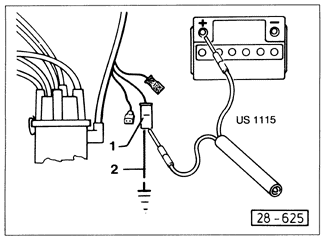CIS-E (engine codes HT, RD, PL)The knock sensor control unit on cars with CIS-E fuel injection (engine code HT, RD, and PL) has a fault memory which records and communicates certain system faults. This information is displayed by connecting an LED test light to the test connection of the wiring harness near the ignition coil. The test connection is a single wire, either blue or blue/brown, leading to pin 4 of the knock sensor control unit. To read the fault memory, connect an LED test light between the test connection and the battery positive (+) terminal, as shown in Fig. 4-7. When the ignition is turned on, the LED should light, indicating that the control unit is responding. If it doesn't, check the connections and check for continuity of the wire from the test connector to terminal 4 of the knock sensor control unit connector. If there is continuity, the knock sensor control unit may be faulty.

Start the engine and briefly raise the engine speed to at least 3000 rpm. If the LED test light goes out, there is no fault information stored, and the system is operating correctly. If it does not go out, or if it goes out and comes back on, there is a fault in the system. Leave the engine idling and the LED test light connected, and connect a jumper wire from the test connector to ground, as shown in Fig. 4-7 above. Hold the connection for at least three seconds. The test light should flash in coded intervals. If the light does not flash, the control unit is faulty and should be replaced.
Two flashes per interval indicates a fault in either the circuit wiring, the knock sensor, or the knock sensor control unit. See 4.5 Checking and Replacing Knock Sensor to continue troubleshooting. Three flashes per interval indicates a problem with the vacuum connection to the knock sensor control unit. Check the vacuum hose for breaks and replace it if necessary. If there are no breaks, the control unit is faulty and should be replaced. |